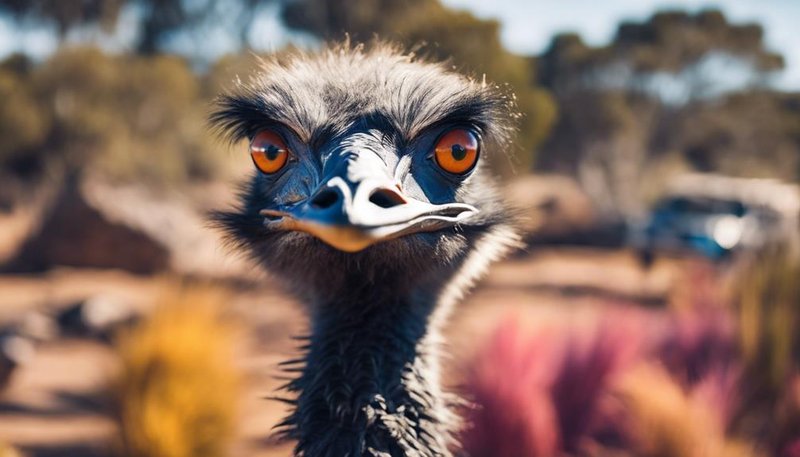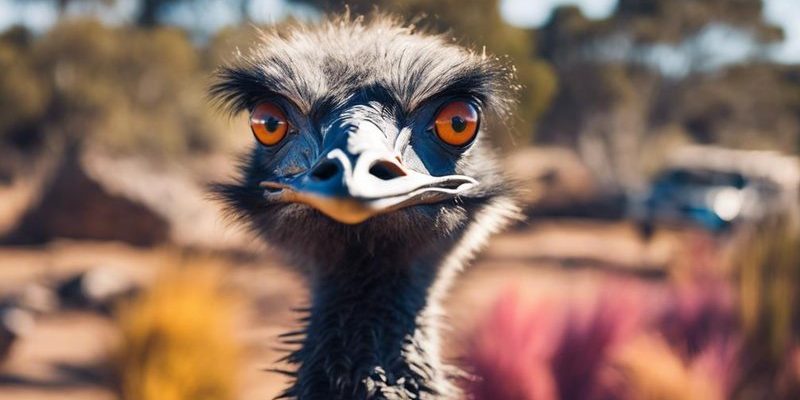
Imagine the emu as a bridge between the natural world and human storytelling. Just as we craft tales of adventure and heroism, different cultures have woven the emu into their narratives, giving it unique meanings. It’s like when a friend tells you about a quirky character in a book—you start to see that character in a new light, reflecting certain traits or lessons. Let’s take a closer look at how the emu has found its way into various forms of folklore and cultural expressions.
The Emu in Aboriginal Australian Mythology
In Aboriginal culture, the emu is not just a bird; it symbolizes various spiritual beliefs and stories. For many Indigenous Australians, the emu’s significance ties back to creation myths and the Dreamtime—a time when ancestral spirits roamed the Earth. One popular story involves the emu leading a group of animals to find water. This journey not only illustrates the bird’s role as a guide but also reinforces themes of survival and interconnectedness in nature.
The emu’s representation can vary among different tribes. Some might see it as a trickster or a symbol of resilience, while others may view it as a provider of sustenance, highlighting its importance in the Aboriginal diet. These stories are passed down through generations, often through oral tradition, helping preserve the cultural identity and teachings of the community.
Folklore and Legends Around the World
Beyond Australia, emus have made their presence felt in other cultures, too. In some Pacific Island nations, these birds appear in local tales where they embody strength and endurance. For instance, there’s a legend that speaks of an emu racing against other birds. The emu, with its powerful legs, showcases not just physical prowess but also the idea of determination in the face of challenges.
In addition to these stories, emus sometimes appear in folk art and handicrafts, with craftsmen depicting these birds to symbolize the beauty of the natural world and its creatures. These representations often serve as a reminder of the importance of preserving wildlife and respecting nature’s balance.
Emu Symbolism in Art and Literature
The emu’s striking appearance has inspired artists and writers alike. In contemporary art, emus are often stylized to evoke feelings of freedom or to represent the wild spirit of Australia. Artists may use bright colors and bold strokes to capture the emu’s lively essence, reflecting how these birds roam the landscape with grace despite their size.
Literature also draws from the emu’s uniqueness. Authors have used the emu as a symbol of the loss of innocence or the journey of self-discovery. When reading a passage about an emu frolicking through a field, you might find yourself reflecting on the joy of simple moments, or perhaps even feeling a sense of nostalgia for childhood adventures. It’s fascinating how a bird can encapsulate such deep emotions.
Emus in Popular Culture
You might be surprised to learn that emus have also found their way into popular culture. They pop up in movies, cartoons, and even social media memes. For instance, there are animated films where emus are portrayed as humorous sidekicks, adding a dose of levity to the storyline. This representation highlights a playful side of the emu, allowing audiences to connect with the bird on a more personal level.
Moreover, with the rise of ecotourism, emus have become a symbol of Australia’s wildlife conservation efforts. Tourists flock to national parks, not just to see kangaroos, but also to catch a glimpse of emus in their natural habitat. This popularity has prompted discussions around protecting these birds and their environment, showcasing how culture and wildlife can influence one another.
Emu Myths and Misunderstandings
Despite their positive representations, emus can also be misunderstood. Some myths portray them as aggressive animals, fueling fears among those unfamiliar with their behavior. Here’s the thing: emus, like many wild animals, will react to threats by running away rather than attacking. Understanding their nature helps dispel these misconceptions, allowing people to appreciate emus for the unique creatures they are.
This misunderstanding sheds light on a broader theme in cultural storytelling: how fear can shape perceptions of wildlife. By sharing accurate information about emus, we can contribute to a more balanced view that reflects their true characteristics, promoting empathy and respect for these fascinating birds.
The Emu in Traditional Practices
In some Indigenous cultures, emu feathers and other body parts have been used in traditional practices. Feathers might be incorporated into ceremonial clothing or used in art to create intricate designs. This not only honors the emu but also serves as a way to connect with the spiritual world.
Additionally, emus provide sustenance. Their eggs, rich in nutrients, have been a food source for many communities. A single emu egg can be quite large—about the size of a cantaloupe! It’s interesting how these practical uses intertwine with deeper cultural meanings, showcasing the emu as a vital part of life and tradition.
Conservation and Cultural Significance Today
Today, emus symbolize not just wildlife but also a commitment to conservation. As their habitats face threats from urbanization and climate change, cultural narratives surrounding emus push for awareness and preservation. Many organizations highlight the emu’s role in ecosystems, emphasizing their importance in maintaining balance within nature.
By celebrating the emu in cultural stories and practices, we can inspire future generations to cherish and protect these birds. Imagine a world where children grow up learning about emus not just in books but through experiences and stories shared around the campfire. It’s a beautiful way to foster respect for nature and all its inhabitants.
Closing out this exploration of the emu’s presence in culture and folklore, it’s clear that these birds are more than just a curiosity in the animal kingdom. They represent resilience, adaptability, and a connection to the natural world. As we engage with stories and traditions involving the emu, we not only celebrate its uniqueness but also reinforce the need for conservation and respect for wildlife. So next time you see an emu or hear its distinctive call, take a moment to appreciate the rich tapestry of culture and folklore woven around this remarkable bird.

